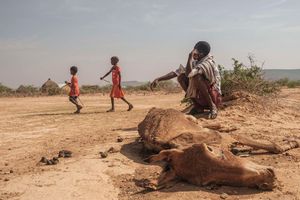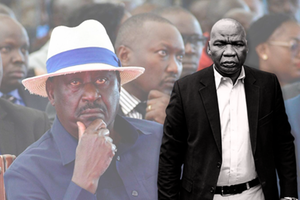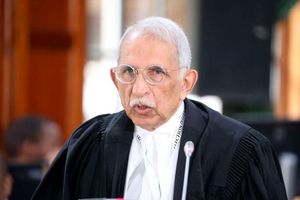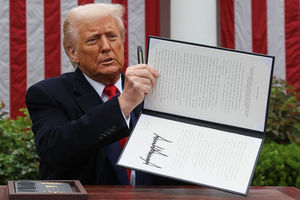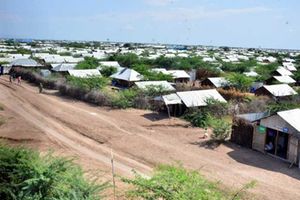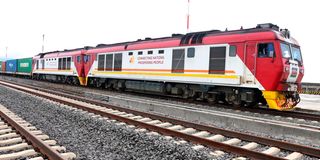
An SGR train at the Naivasha Inland Container Depot on January 17, 2022.
“Modernise and industrialise or perish.” This was the clarion call by speakers at the Hong Ting Forum on “China-Africa Dialogue on the Path to Modernisation” organised by Xinhua News Agency Africa Bureau in Nairobi on April 2, 2025.
I was a speaker at the forum, which subtly called on the nations of the Global South to chart their own pathways to modernisation and steer clear of ethnocentric versions of Western modernity, which have stifled industrialisation, deepened poverty and reinforced inequalities within and between nations.
We now know that Kenya cannot industrialise without its own homegrown model of modernisation. Lessons from the past have shown that modernisation imported or imposed upon a society can have calamitous results.
Transforming Kenya into a newly industrialising middle-income country by 2030 is the supreme goal of the Kenya Vision 2030, which expires in less than five years. Kenya has to return to its true North — its national interests — to find its own path to modernisation and industrialisation as the only way to create new jobs for its children below the age of 18 years, who form 46 percent (21.9 million) of its population.
Scholars of China-Africa relations have turned a sharp spotlight on the two most important concepts shaping the future of global power. The first concept is dialogue. The call for dialogue is an open rejection of war-mongering theories like Samuel Huntington’s ‘Clash of Civilizations’, Robert D. Kaplan’s ‘The Coming Anarchy’ or Graham T. Allison’s ‘Thucydides Trap’ where human civilizations appear armour-plated, ready for war.
The second concept is modernisation, a theory that envisions societies progressing from traditional to modern forms characterised by higher technologies and industrialisation.
The history of many nations in the Global South has made it crystal clear that externally imposed models of modernisation only deepen poverty and underdevelopment, often leading to cycles of conflict, destruction and death. More blissfully, homegrown forms of modernisation have transformed, both qualitatively and quantitatively, rural and agrarian societies to higher, urban and industrial ones, leading to poverty eradication and to fairer and prosperous nation.
External forces
In this regard, China and Africa have chosen the path of independent modernisation and peaceful development, paved by dialogue. The story of China-Africa dialogue on modernisation starts as an epic tale of two civilizations that met, joined hands and walked together as equals along the enchanted ancient “Silk Roads” — where human civilisations exchanged goods, services and ideas about values, religions, cultures, economies and forms of government. But their dreams were deferred, cut short when both civilisations were conquered, occupied, exploited and humiliated by external forces after 1840.
Tragically, imposed western models of modernisation failed to drive social-economic development. It has dawned on all of us that modernisation is not equal to westernisation. Besides being a tool of cultural, economic and political domination, western-style modernisation was weaponised during the Cold War geopolitics as an instrument of foreign policy and Western global hegemony.
China paid heavily for external models of modernisation. Prior to adopting its Reform and Opening-up policy in 1978, the world’s second superpower was one of the poorest countries by all measures. By 1980, only two African countries had a lower GDP per capita than China: Guinea-Bissau and Uganda. Over the next 40 years, China has become the world’s second-largest economy with a world-class military.
It had lifted an estimated 850 million of its citizens from the abyss of absolute poverty, representing about 70-75 per cent of the global reduction in extreme poverty over the same period. By 2021, Beijing declared a complete victory in its fight against absolute poverty, lifting nearly 100 million rural residents out of poverty, a decade ahead of the expiry of the UN 2030 Agenda for Sustainable Development.
Alien models of modernisation imposed upon Africa have also been extremely expensive for the continent. As China embarked on its homegrown modernisation, signified by the Reform and Opening-up policy, Africa sank into the “lost decades” of 1980-2000 when it had its worst publicity, willy-nilly written off by Western investors as a “hopeless continent.”
However, in the new millennium, Africa has pursued its own model of modernisation to meet its development aspirations. Its thinkers and leaders embraced the idea of ‘African Renaissance’ as a concept that envisioned Africa’s cultural, scientific, and economic renewal, traced to the writings of Senegalese historian, Cheikh Anta Diop, and popularised by South Africa’s second President Thabo Mbeki.
Modernisation
In the twenty-first century, the story of modernisation in China and Africa has increasingly become a beautiful tale of two paths, one destiny. Today, Chinese-style modernisation meets African modernisation in the dream of ‘African Renaissance’. The year 2025 marks two decades since China and Africa formed the Forum on China-Africa Cooperation (FOCAC) as the premier forum for inter-civilizational dialogue on modernisation. Between 2000 and 2024, China has set aside over US$245 billion to support Africa’s modernization, including US$94.4 billion between 2000 and 2015, US$60 billion in 2018, US$40 billion in 2021 and approximately US$51 billion in 2024. It is supporting African Agenda 2063, Africa’s efforts to realize its Continental Free Trade Area (CFTA) and the continent’s stabilization.
In Kenya, China’s support for modernisation has led to the emergence of the fastest-growing Economic Belt along the Mombasa-Nairobi-Naivasha Railway, expected to expand to Malaba on the Kenya-Uganda border and beyond. While the railway has raised the country’s GDP by 1.5 per cent, it is projected to contribute 2-3 per cent of the country’s GDP by 2030.
Kenya needs to relook at its pro-West foreign policy strategy, recommit to its national interests and leverage the surge of new technologies galvanizing rapid socio-economic transformation in China and the Global South. Only South-South partnerships can help it industrialize, lift millions of its poor from poverty and create new jobs for its burgeoning youth population.
Professor Peter Kagwanja is the Chief Executive at the Africa Policy Institute and Co-author of The Power of Minerals: How Africa Can Benefit from the Green Energy Revolution (2025).

